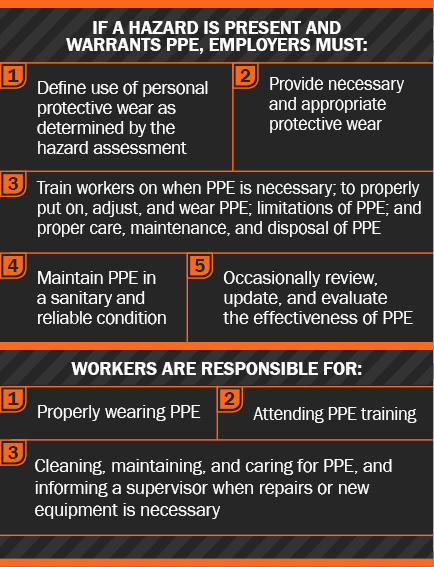Choosing PPE to Protect Against Poisons in the Workplace
03
February,
2023
3 MINUTE READ

Poisons and hazardous chemicals are present in nearly every industry. Farmers and agricultural workers may encounter pesticides; lab employees and scientists may mix, study, and experiment with solvents and new compounds; and construction workers may be at risk for inhaling paint and dangerous dust particles.
Fortunately, proper PPE can protect against dangerous chemicals, airborne hazards, and other poisons present on jobsites. To keep workers safe, it's important to know when PPE may be required, which types should be used, and how it can help keep employees safe.
How can employees become exposed to poisons and other hazards?
Workers are generally exposed to toxic chemicals and other poisons in one of three ways:
- Skin and eye contact: This occurs when an employee (not wearing proper PPE) comes into contact with a hazardous material or chemical. This may cause numerous symptoms, including skin or eye irritation, rashes, and burns.
- Inhaling hazardous vapors: An employee may breathe in toxic fumes while working in an area without proper ventilation or while working without a respirator. Doing so may lead to respiratory illnesses or lung cancer.
- Swallowing toxic chemicals: This may happen when hands or foods are contaminated, and poisons are ingested. Swallowing poisonous materials may lead to a variety of side effects, including dizziness, skin irritation, organ damage, and more.
 What does OSHA have to say about PPE requirements?
What does OSHA have to say about PPE requirements?
OSHA has a variety of requirements regarding PPE in the workplace, many of which vary by industry. (Shipyards have their own standard, for instance, as does construction and demolition work.) General requirements that apply to most workplaces may be found in 29 CFR 1910.132.
OSHA's PPE requirements direct employers to conduct a hazard assessment of their workplaces and provide proper PPE accordingly.
How do employers know which PPE to use when working with hazardous chemicals?
Each container of hazardous chemicals should be labeled, and should have a detailed safety data sheet (SDS) available to describe its hazards and the appropriate precautions. These two elements are required in OSHA's HazCom 2012 standard.
Container labels include the name of the material and information about the hazards that material may pose. An SDS includes more extensive information employees may need to know when working with dangerous chemicals, including first-aid measures and any required PPE.
How can PPE protect against poisons and other hazardous chemicals?
Proper PPE comes in many forms and protects against numerous hazardous chemicals. The following types of PPE are especially helpful in protecting against poisons and other hazards:
Foot and Leg Protection: Durable boots can protect against chemicals that have spilled, including paint and pesticides. Employees may wear shoe covers to prevent contact with a contaminated surface. Foot protection should be compliant with the ANSI Z41.1 standard, which sets the criteria for testing, selecting, maintaining, and using foot protection in American workplaces.
Hand Protection: Gloves can protect employees when handling chemicals and other hazards, or while working on contaminated surfaces. Chemical-resistant gloves may be made from natural rubber, neoprene, nitrile, polyvinyl chloride (PVC), polyethylene, or other substances to protect against hazardous chemicals.
Body Protection: Aprons, coats, gowns, and full-body suits-sometimes coated in polyethylene for added protection-may be made from rubber, leather, or synthetics. Effective body protection blocks hazards posed by particles, aerosols, and chemicals that may splash onto an employee.
Respiratory Protection: Respirators are essential to keep from breathing air contaminated with gases, vapors, fumes, sprays, dusts, fogs, mists, or smoke. Respirators may cover the nose and mouth, a worker's entire face, or the entire head. All respirators must be approved by the National Institute for Occupational Safety and Health.
Note: An employer must provide a medical evaluation and training before an employee may use a respirator, and all employees should ensure their respirator fits properly, seals out hazardous air, and that it's properly cleaned, stored, and maintained.
Eye and Face Protection: Safety glasses, goggles, and face shields can protect against splashes. All eyewear should be compliant with the ANSI Z87.1 and CSA Z94.3 standards, which set the criteria for testing, selecting, maintaining, and using of eye protection in American and Canadian workplaces, respectively.
How can Duralabel help ensure workers are outfitted with proper PPE?
Labeling and premade signage can alert employees to the PPE required when working with dangerous chemicals and hazards present in the workplace. DuraLabel industrial label and sign printers by Duralabel can assist in developing custom visual communication. With several, tough-tested printers and more than 50 specialty label supplies, you'll find the right tools to help your employees remain safe.
Effective Employee Training
Download this free EHS Management Guide to help as you train employees on mandates throughout your facility. Get your free download below.
RELATED RESOURCES

Fault Current Calculations
A fault current is an unintended, uncontrolled, high current flow through an electrical system. Fault ...
Read
Arc Flash PPE
Personal Protective Equipment (PPE) is the last line of defense against injuries. When it comes to arc flash, ...
Read
Arc Flash Boundary
NFPA 70E is the major industrial standard for safe electrical work in the United States. It defines three ...
Read.png)


